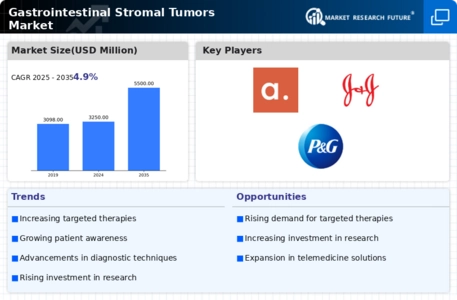Advancements in Targeted Therapies
The development of targeted therapies represents a transformative shift in the treatment landscape for gastrointestinal stromal tumors. These therapies, which specifically target the molecular pathways involved in GISTs, have shown promising efficacy in clinical trials. For instance, imatinib, a tyrosine kinase inhibitor, has become a cornerstone in GIST management, leading to improved survival rates. The Gastrointestinal Stromal Tumors Market is witnessing a surge in research focused on novel agents that can enhance treatment efficacy and minimize side effects. As more targeted therapies receive regulatory approval, the market is likely to expand, offering patients a broader array of treatment options. This trend not only reflects the ongoing innovation in oncology but also underscores the importance of personalized medicine in addressing the unique characteristics of GISTs.
Emerging Biomarkers for Early Detection
The identification of emerging biomarkers for gastrointestinal stromal tumors is poised to revolutionize the early detection and management of GISTs. Biomarkers can facilitate the diagnosis of GISTs at earlier stages, potentially leading to improved patient outcomes. The Gastrointestinal Stromal Tumors Market is likely to benefit from advancements in biomarker research, as these discoveries can enhance screening protocols and inform treatment decisions. As the understanding of the molecular underpinnings of GISTs evolves, the integration of biomarker testing into clinical practice may become standard. This shift could not only improve the accuracy of diagnoses but also enable more personalized treatment strategies, thereby contributing to the overall growth of the Gastrointestinal Stromal Tumors Market.
Rising Awareness and Education Initiatives
The increasing awareness surrounding gastrointestinal stromal tumors is significantly influencing the Gastrointestinal Stromal Tumors Market. Educational initiatives aimed at healthcare professionals and the general public are crucial for improving early detection and treatment outcomes. Organizations dedicated to GIST advocacy are actively promoting awareness campaigns, which may lead to a higher rate of diagnosis and subsequent treatment. As more individuals become informed about the symptoms and risks associated with GISTs, the demand for diagnostic services and therapeutic interventions is likely to rise. This heightened awareness not only fosters a more informed patient population but also encourages healthcare providers to prioritize GISTs in their clinical practice, thereby driving growth in the Gastrointestinal Stromal Tumors Market.
Increased Investment in Research and Development
Investment in research and development (R&D) is a critical driver for the Gastrointestinal Stromal Tumors Market. Pharmaceutical companies and research institutions are allocating substantial resources to explore novel therapeutic approaches and improve existing treatments for GISTs. This influx of funding is facilitating clinical trials aimed at evaluating the safety and efficacy of new drugs, including combination therapies and immunotherapies. The market is expected to benefit from these advancements, as successful R&D initiatives can lead to the introduction of innovative treatment options that address unmet medical needs. Furthermore, collaborations between academia and industry are likely to enhance the pace of discovery, ultimately contributing to the growth of the Gastrointestinal Stromal Tumors Market.
Growing Incidence of Gastrointestinal Stromal Tumors
The rising incidence of gastrointestinal stromal tumors (GISTs) is a pivotal driver for the Gastrointestinal Stromal Tumors Market. Recent data indicates that GISTs account for approximately 1-3% of all gastrointestinal tumors, with an increasing number of diagnoses reported annually. This trend is likely influenced by enhanced awareness and improved diagnostic techniques, which facilitate earlier detection. As the population ages, the prevalence of GISTs may further escalate, thereby propelling demand for effective treatment options. The growing patient pool necessitates advancements in therapeutic modalities, including targeted therapies and surgical interventions, which are crucial for improving patient outcomes. Consequently, the increasing incidence of GISTs is expected to significantly impact the growth trajectory of the Gastrointestinal Stromal Tumors Market.

















Leave a Comment